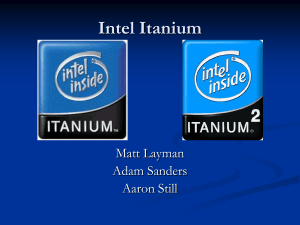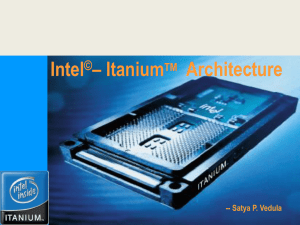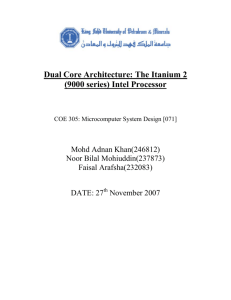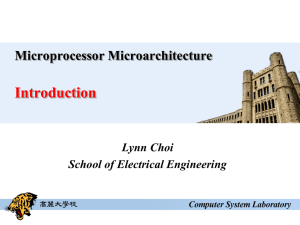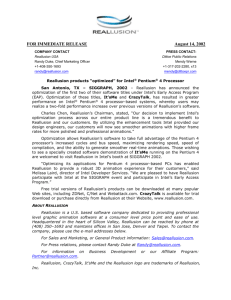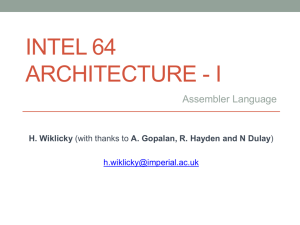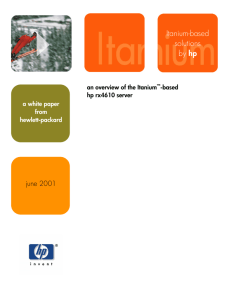Understanding IA-64 and Itanium
advertisement
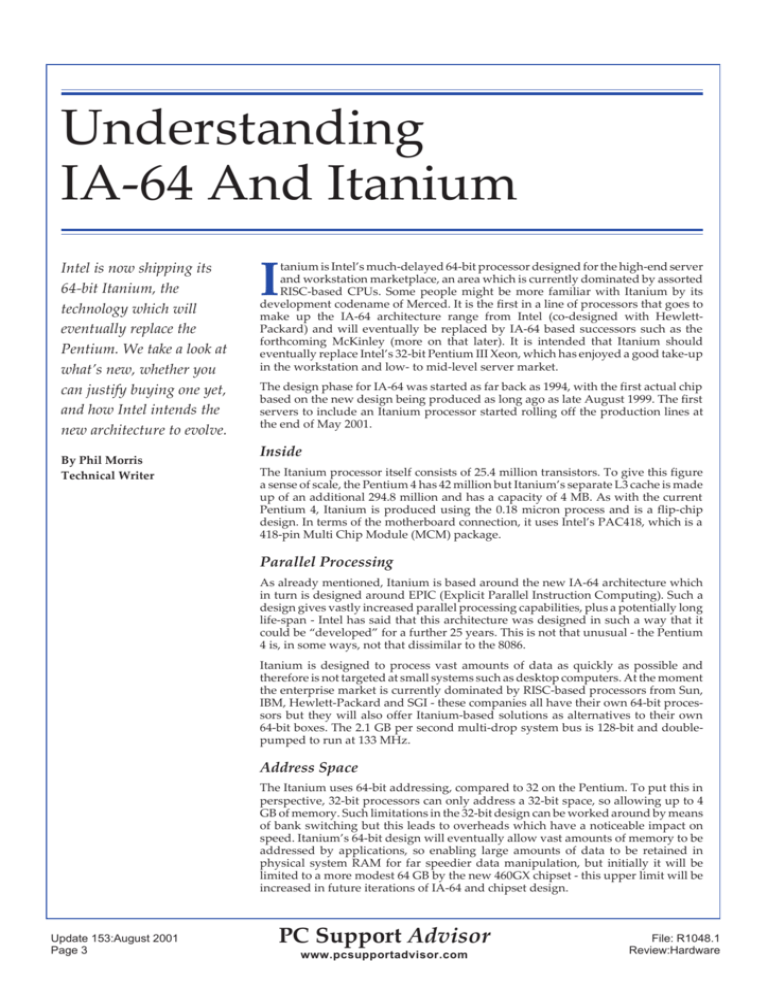
Understanding IA-64 And Itanium Intel is now shipping its 64-bit Itanium, the technology which will eventually replace the Pentium. We take a look at what’s new, whether you can justify buying one yet, and how Intel intends the new architecture to evolve. By Phil Morris Technical Writer I tanium is Intel’s much-delayed 64-bit processor designed for the high-end server and workstation marketplace, an area which is currently dominated by assorted RISC-based CPUs. Some people might be more familiar with Itanium by its development codename of Merced. It is the first in a line of processors that goes to make up the IA-64 architecture range from Intel (co-designed with HewlettPackard) and will eventually be replaced by IA-64 based successors such as the forthcoming McKinley (more on that later). It is intended that Itanium should eventually replace Intel’s 32-bit Pentium III Xeon, which has enjoyed a good take-up in the workstation and low- to mid-level server market. The design phase for IA-64 was started as far back as 1994, with the first actual chip based on the new design being produced as long ago as late August 1999. The first servers to include an Itanium processor started rolling off the production lines at the end of May 2001. Inside The Itanium processor itself consists of 25.4 million transistors. To give this figure a sense of scale, the Pentium 4 has 42 million but Itanium’s separate L3 cache is made up of an additional 294.8 million and has a capacity of 4 MB. As with the current Pentium 4, Itanium is produced using the 0.18 micron process and is a flip-chip design. In terms of the motherboard connection, it uses Intel’s PAC418, which is a 418-pin Multi Chip Module (MCM) package. Parallel Processing As already mentioned, Itanium is based around the new IA-64 architecture which in turn is designed around EPIC (Explicit Parallel Instruction Computing). Such a design gives vastly increased parallel processing capabilities, plus a potentially long life-span - Intel has said that this architecture was designed in such a way that it could be “developed” for a further 25 years. This is not that unusual - the Pentium 4 is, in some ways, not that dissimilar to the 8086. Itanium is designed to process vast amounts of data as quickly as possible and therefore is not targeted at small systems such as desktop computers. At the moment the enterprise market is currently dominated by RISC-based processors from Sun, IBM, Hewlett-Packard and SGI - these companies all have their own 64-bit processors but they will also offer Itanium-based solutions as alternatives to their own 64-bit boxes. The 2.1 GB per second multi-drop system bus is 128-bit and doublepumped to run at 133 MHz. Address Space The Itanium uses 64-bit addressing, compared to 32 on the Pentium. To put this in perspective, 32-bit processors can only address a 32-bit space, so allowing up to 4 GB of memory. Such limitations in the 32-bit design can be worked around by means of bank switching but this leads to overheads which have a noticeable impact on speed. Itanium’s 64-bit design will eventually allow vast amounts of memory to be addressed by applications, so enabling large amounts of data to be retained in physical system RAM for far speedier data manipulation, but initially it will be limited to a more modest 64 GB by the new 460GX chipset - this upper limit will be increased in future iterations of IA-64 and chipset design. Update 153:August 2001 Page 3 PC Support Advisor www.pcsupportadvisor.com File: R1048.1 Review:Hardware Understanding IA-64 And Itanium SGI has plans to one day build machines using 512 Itanium processors, so giving access to over a Terabyte of data in main memory. Speaking of memory, one of the points against the initial range of Pentium 4 processors is the type of RAM that it and its chipset uses, namely the more expensive RDRAM. Intel has been far more sensible in this area with its Itanium and 460GX chipset design as they can still utilise PC100 SDRAM and PC1600 DDR SDRAM. Up to four Itaniums (Itania?) are capable of being supported with the first release of the chipset - these will be mounted in pairs on both sides of Itanium motherboards, therefore one pair per side. Caches The Itanium is comprised of some fast caches - the L1 cache is 32 KB in total (16 KB integer data + 16 KB instruction), the L2 cache is 96 KB - both of these are on-die caches. The L3 cache is on the cartridge and will be either 2 MB or 4 MB (depending on which Itanium is purchased) running at the core clock speed with a 128-bit bus. There are also four pipelined FMAC (Floating-point Multiply Add Calculator) units - two are for floating point operations while the other two are for 3D applications. Four pipelined ALUs (Arithmetic Logic Units) are also present - these can also process MMX-type instructions. Also featured is extensive error handling and reliability - applications or threads that have generated an error can be terminated by the processor and as a consequence of this there is no need to reboot. Current Itaniums use dual memory SDRAM - later Itaniums will be able to use DDR SDRAM and RDRAM (although the latter option could be prohibitively expensive if RDRAM retains its current relatively high price). In terms of adapter cards, Itanium Motherboards will have the capability to support 64-bit 66 MHz PCI and AGP (4x). Itanium features a wide parallel execution core which basically runs multiple operations and instructions in parallel. Rotating registers are used (128 of which are floating point and 128 are integer) - in a nutshell, rotation means that streams of data are processed more efficiently. A compilation technique called predication is also used which ensures a lot of the code runs in parallel, plus there is something called speculation which is used for the loading of data and instructions to the CPU before it is actually required. As for clock speeds, the first Itaniums run at 733 and 800 MHz (the 800 MHz chip will be released a few months after its slower sibling). Such speeds may not seem very impressive at a glance, but it should be remembered that this is a new architecture and it is still in its infancy. Intel hopes to increase the clock speed as the Itanium line is developed, the next stage of which is code-named McKinley. Also, remember that the number of instructions per second is not as important as the amount of work that each instruction can do. McKinley And Beyond McKinley is the next phase of the logical development of the IA-64 architecture and will commence shipping in a pilot program later this year. In Q1 and Q2 2002, Intel hopes that McKinley will be released to mainstream purchasers and so achieve a greater take-up than Itanium. McKinley differs from Itanium by having the L3 cache on-die plus it will also feature a faster clock speed, although this speed is currently unknown to those outside Intel. “Itanium is fully x86 compatible in hardware, Coming after that, possibly in 2002 though otherwise in 2003, will be the next development, code-named Madison. This will differ further still by using a 0.13 so 32-bit applications micron process as opposed to the 0.18 process used with Itanium and McKinley. Slightly further down the line is the chip code-named Deerfield - this will be cheaper and operating systems than its predecessors but as a consequence will offer less performance (see Figure 1 for the current roadmap for these processors). All these chips should be enhanced should run without any by having higher clock speeds than their predecessors, plus they will feature increased functionality such as larger cache sizes and faster ALUs. modifications, albeit Software Compatibility slower than on a Itanium is fully x86 compatible in hardware, so 32-bit applications and operating similarly clocked systems should run without any modifications, albeit slower than on a similarly Pentium or Xeon CPU. This support is achieved by a decoder on the CPU Pentium or Xeon CPU.” clocked decoding x86 instructions into EPIC instructions which will then also run with increased parallelism. Some early benchmarks for this emulation don’t look too Update 153:August 2001 Page 4 PC Support Advisor www.pcsupportadvisor.com File: R1048.2 Review:Hardware Understanding IA-64 And Itanium promising though. For example, the slower of the two initial Itaniums might only run at the equivalent of a 75 MHz Pentium, or maybe 100 MHz at best. That looks especially poor when compared to some of the speeds that humble x86 software emulation is capable of. Operating System Support Support for 64-bit processors and hence operating systems is nothing new - when running on Sun’s SPARC processors Sun’s Solaris is a 64-bit OS. To give another example, IBM’s AIX takes on the 64-bit mantle when it is running on an RS6000. However, the Itanium is new so OS developers will need to familiarise themselves with the new IA-64 architecture. Full 64-bit Itanium support is currently implemented for Windows XP, IBM AIX 5L (known as Project Monteray and which is being developed with SCO), Novell’s Modesto, Linux and Hewlett Packard’s HP-UX. However, Windows XP is only available in a pre-release version at present, as the OS is not scheduled for general release until the end of October 2001. Useful developer information can be found on Intel’s IA-64 Web site - see the Web Resources section of this article for details. Assorted compilers are, of course, also being developed and will cover various languages such as C/C++ and Fortran95. Hardware Here we have a new chip, a new package and a new chipset, so it is only natural that Itanium will need a new motherboard. Two of HP’s current servers are already “Itanium ready”, namely the 9000 N-Class and L-Class. Curiously enough (for those mostly familiar with Intel’s current desktop processors) Itanium doesn’t feature a fan, just a large heatsink. As for those building hardware around the new processor, OEMs such as IBM, Dell, Compaq, SGI and Hewlett Packard are all shipping systems, or are about to do so in the very near future. AMD In all these Intel discussions, AMD’s 64-bit processors should not be forgotten AMD has been a major thorn in Intel’s side when it comes to processors for desktop PCs, so could it also try to turn the tables in the 64-bit arena? Only time will tell, but it is worth remembering that it has its own x86-64 project underway which was announced in the summer of 2000. The first two processors in this newly named “Here we have a new chip, a new package and a new chipset, so it is only natural that Itanium will need a new motherboard.” Figure 1 - IA Enterprise Processor Roadmap. Update 153:August 2001 Page 5 PC Support Advisor www.pcsupportadvisor.com File: R1048.3 Review:Hardware Understanding IA-64 And Itanium Hammer family are based on AMD’s new 64-bit architecture and are named SledgeHammer and ClawHammer - ClawHammer was originally due for release in 2001 and SledgeHammer in 2002, but both are now due Q3 2002 due to AMD wishing to implement its “silicon on insulator” chip technology - this will make the new processors run faster and consume less power. ClawHammer is aimed at the 64-bit desktop market while SledgeHammer is aimed squarely at the 64-bit Server market. Current speculation indicates that SledgeHammer will run faster than Itanium, plus it could run at a lower temperature - backwards compatibility for 32-bit applications is also expected to be better than Itanium’s 32-bit emulation. Support from prominent figures such as Microsoft will play a key part in the success (or otherwise) of these new processors - I cannot imagine Microsoft ignoring a new 64-bit processor from AMD and various rumours are favourable towards such support, but as yet there is no official statement on the matter. The Itanium Marketplace Various markets will undoubtedly benefit from the use of processors based on the new IA-64 architecture, but some will benefit more than others. To give some examples, such markets as Electronic Design Automation, Global Information Systems, Business Intelligence and Security applications for e-commerce will benefit. CAD industries, along with other computing-intensive applications, will benefit from the more powerful floating point performance. Software development will also see improvements due to the improved handling of object-oriented applications. Itanium And The Desktop Market As mentioned elsewhere, Itanium is fairly and squarely aimed at the high-end server and workstation market so, initially at least, desktop users will not be directly affected. But technologies advance and what was once high-end is superseded and developed, so high-end technology becomes the standard on mid- or low-range machines. In five to 10 years, who knows for sure what processor technology might be in use in the average desktop machine? Who could have accurately foreseen the advent of the Pentium chip all those years ago, when the 8086 first made an appearance in desktop PCs? Conclusion Itanium has been in development for so long that a lot of interest has built up around it, but is there the potential for it to stumble across some rough ground ahead? Here we have a brand new 64-bit processor design from Intel, but this begs the question: will the stability be good enough? Such an issue is bound to cause concerns for those implementing Itanium in mission-critical servers, especially as 64-bit Windows is also a very new product too. Compatibility also needs to be assured with existing 64-bit applications which are currently in use by other 64-bit architecture machines such as those outlined earlier. Intel has announced that approximately 400 of the most popular 64-bit applications have either been ported to the new IA-64 architecture or will be ported in the very near future. Web Resources Intel’s Itanium site developer.intel.com/design/ ia-64/index.htm Vendors committed to Itanium developer.intel.com/design/ ia-64/commit.htm As it is the first processor in the new line, it could be argued that Itanium is more of a development design which is being used to iron out any developmental problems with the new architecture. This could of course be applied (and has been) to other new processors that are also the first in a new line. Pre-production Itaniums have though been tested at assorted sites around the world in order to quash such developmental bugs, but the biggest test will come now that early machines are actually shipping. Would potential Itanium purchasers do well to sit and wait for the second-generation McKinley? After all, McKinley is purported to be much faster than Itanium. Be that as it may, Itanium should give purchasers a greater choice of hardware vendors than is currently available, plus a greater choice of which OS they prefer to run on the purchased system. If the IA-64 range gains universal acceptance, Intel could very well end up dominating the market from the low-end desktop all the way up to high-end servers. HP’s Itanium Home Page www.hp.com/products1/ itanium/ PCSA Copyright ITP, 2001 Update 153:August 2001 Page 6 PC Support Advisor www.pcsupportadvisor.com File: R1048.4 Review:Hardware New Reviews from Tech Support Alert Anti-Trojan Software Reviews A detailed review of six of the best anti trojan software programs. Two products were impressive with a clear gap between these and other contenders in their ability to detect and remove dangerous modern trojans. Inkjet Printer Cartridge Suppliers Everyone gets inundated by hundreds of ads for inkjet printer cartridges, all claiming to be the cheapest or best. But which vendor do you believe? Our editors decided to put them to the test by anonymously buying printer cartridges and testing them in our office inkjet printers. Many suppliers disappointed but we came up with several web sites that offer good quality cheap inkjet cartridges with impressive customer service. Windows Backup Software In this review we looked at 18 different backup software products for home or SOHO use. In the end we could only recommend six though only two were good enough to get our “Editor’s Choice” award The 46 Best Freeware Programs There are many free utilities that perform as well or better than expensive commercial products. Our Editor Ian Richards picks out his selection of the very best freeware programs and he comes up with some real gems. Tech Support Alert http://www.techsupportalert.com
